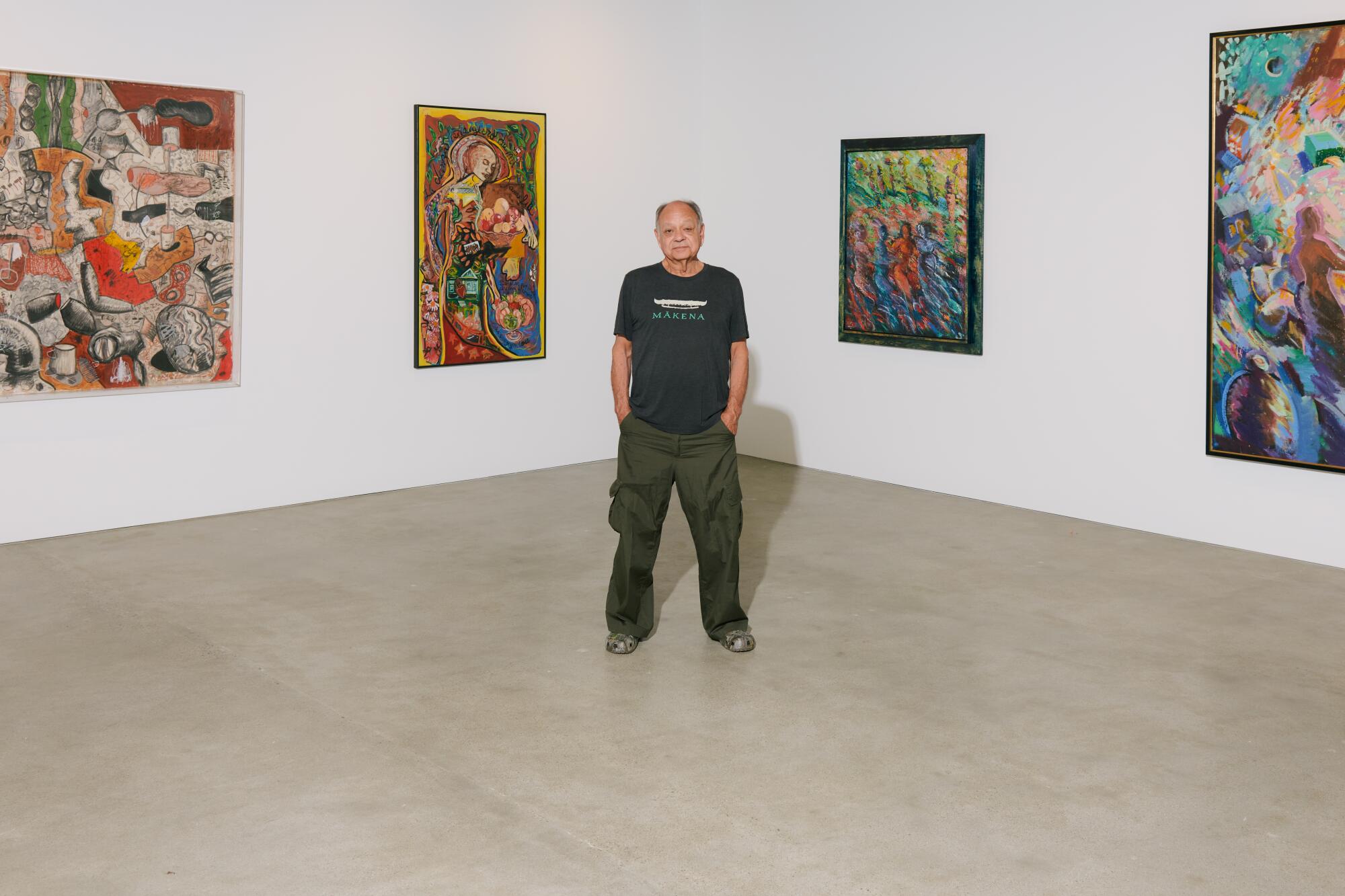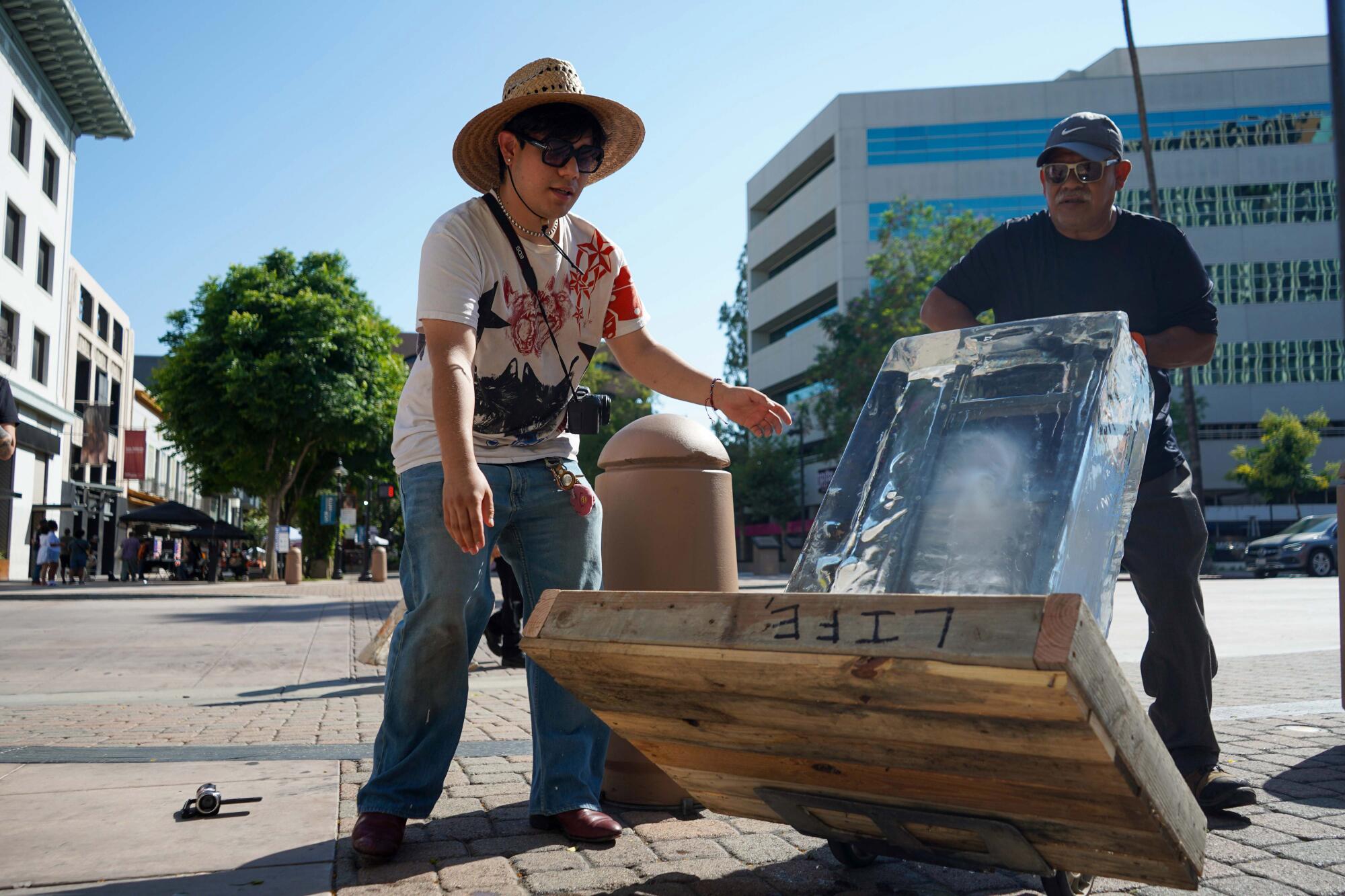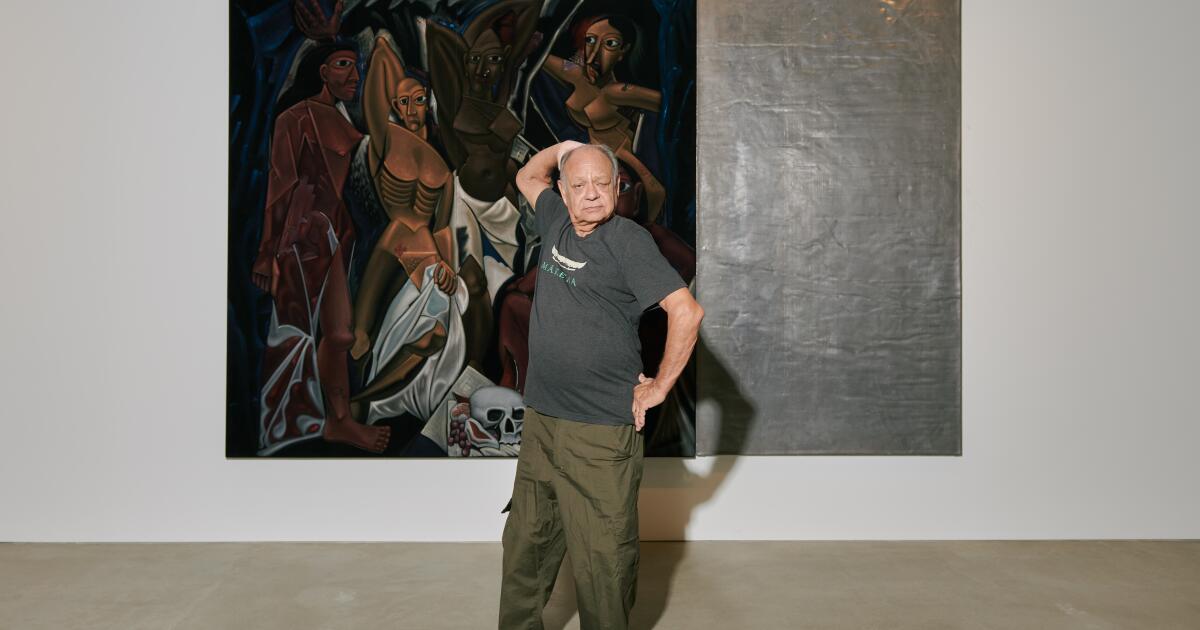Cheech Marin’s museum legitimizes Chicano art and boosts local economy
“The fame of the museum is spreading far and wide, and people are coming from all over the United States,” says the award-winning comedian and museum founder
In 2022, the iconic L.A. comedian Cheech Marin opened an art museum with the hope of inspiring a Chicano art renaissance.
“I looked around and said, ‘This could be the next big art town’ — because the foundations were already there,” Marin told De Los. “There was this kind of nebulous underground here, but [they’ll] reach officialdom when they have their museum.”
Now, as the Cheech Marin Center for Chicano Art and Culture enters its fourth year, Marin said he believes his goal is slowly coming true.
Known colloquially as the Cheech, the museum is widely considered the only space in the nation that exclusively showcases Chicano art. It’s located in Riverside, a majority-Latino city which is also within one of the largest Latino-populated counties in the country.
Since its grand opening on June 17, 2022, the center has housed hundreds of artworks from Marin’s vast private collection, including from prominent artists such as Wayne Alaniz Healy, Judithe Hernández and Frank Romero.
In its first two years, the space attracted over 200,000 visitors, according to an independent study commissioned by the city, with around 90% of attendees coming from outside the Inland Empire. The study also found that the Cheech brought around $29 million into the city’s local economy in that time frame.
“We were recognized as one of the top 50 shows in the world,” Marin said. “The fame of the museum is spreading far and wide, and people are coming from all over the United States.”
While the Cheech grew in nationwide prominence, its artistic director, María Esther Fernández, explained that the museum’s team also worked to fulfill Marin’s goal by taking advantage of its rapid success.
In the last three years, the center has become a hub and vital resource for many of the region’s Chicano artists. It has done this by creating opportunities to network with high-profile individuals, hosting recurring professional development workshops and regularly contracting emerging creatives for different design projects.
Drew Oberjuerge, the center’s former executive director, added that the museum has invested in the region’s economy by hiring locals to help prepare artwork for installation while also paying musicians and other contractors to work throughout their events.
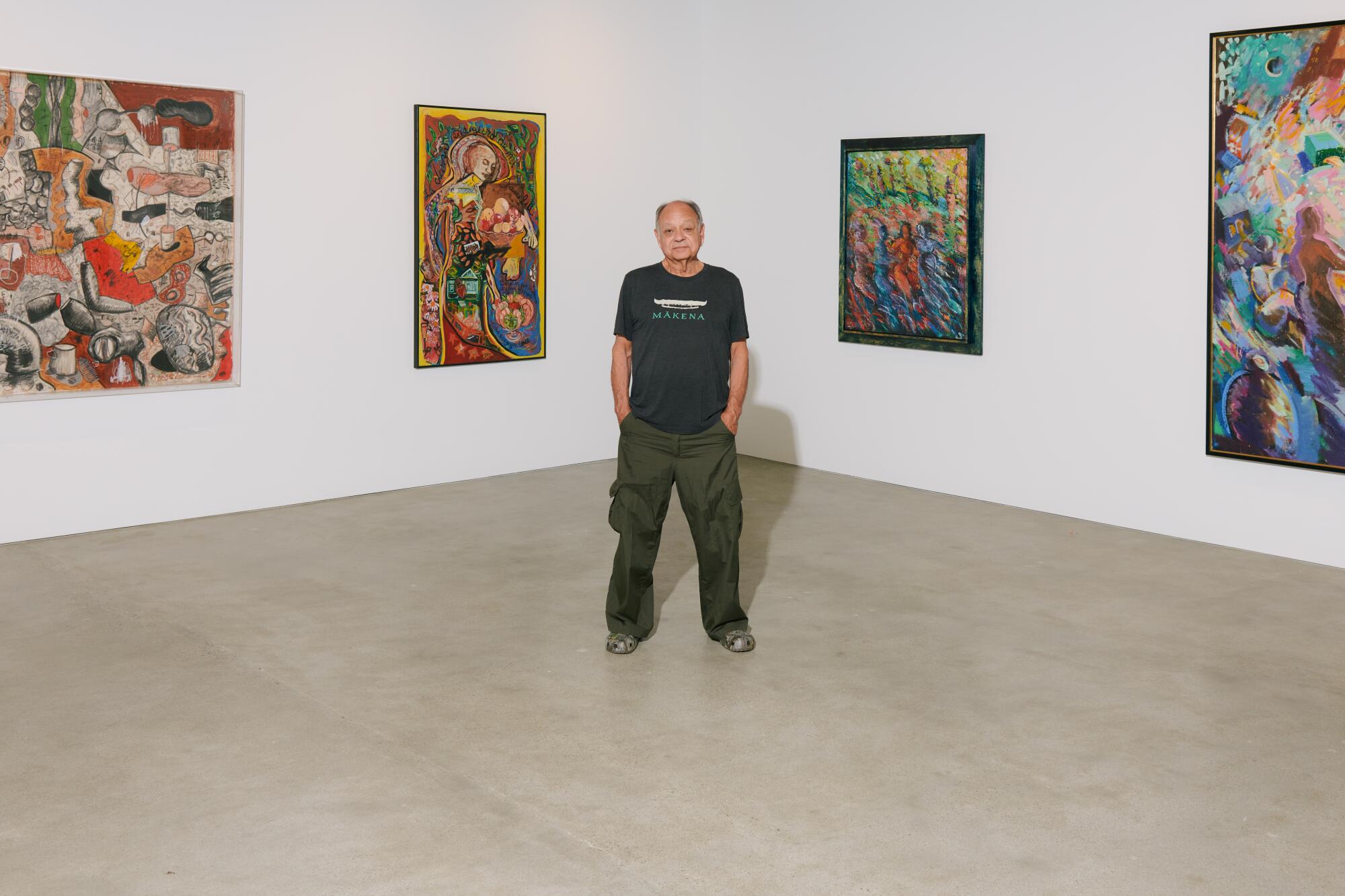
Cheech Marin photographed in the Riverside Art Museum for the unveiling of the Cheech Marin Center for Chicano Art & Culture (a.k.a. “The Cheech”) in 2022.
(Gustavo Soriano / For The Times)
Most important for these artists, however, is the space that the Cheech has designated to put their art front and center.
“What we’ve been really lucky to leverage is the visibility of the Cheech,” Fernández said. “We’ve been really dedicated, since we opened, to featuring artists that are emerging or some that are even mid-career in the community gallery.”
Some of the creatives, who have collaborated with the Cheech within the community gallery since it first opened, say the center’s efforts have legitimized their career paths and created new opportunities to help pursue their dreams.
The gallery is located next to the museum’s entrance and is only a fraction of the space given to the other exhibits within the 61,420-square-foot museum — and it feels like being in a waiting room in comparison to the rest of the center too. Yet, on only four small walls, the artists featured in the area have put on powerful exhibitions that tell the region’s story while also making art on par with Marin’s collection.
This includes shows like “Desde los Cielos,” which was co-curated by Perry Picasshoe and Emmanuel Camacho Larios, and looked into the concept of alienness — as well as Cosme Córdova’s “Reflections of Our Stories,” which emphasized a cultural connection between Inland Empire artists, despite the use of vastly different mediums.
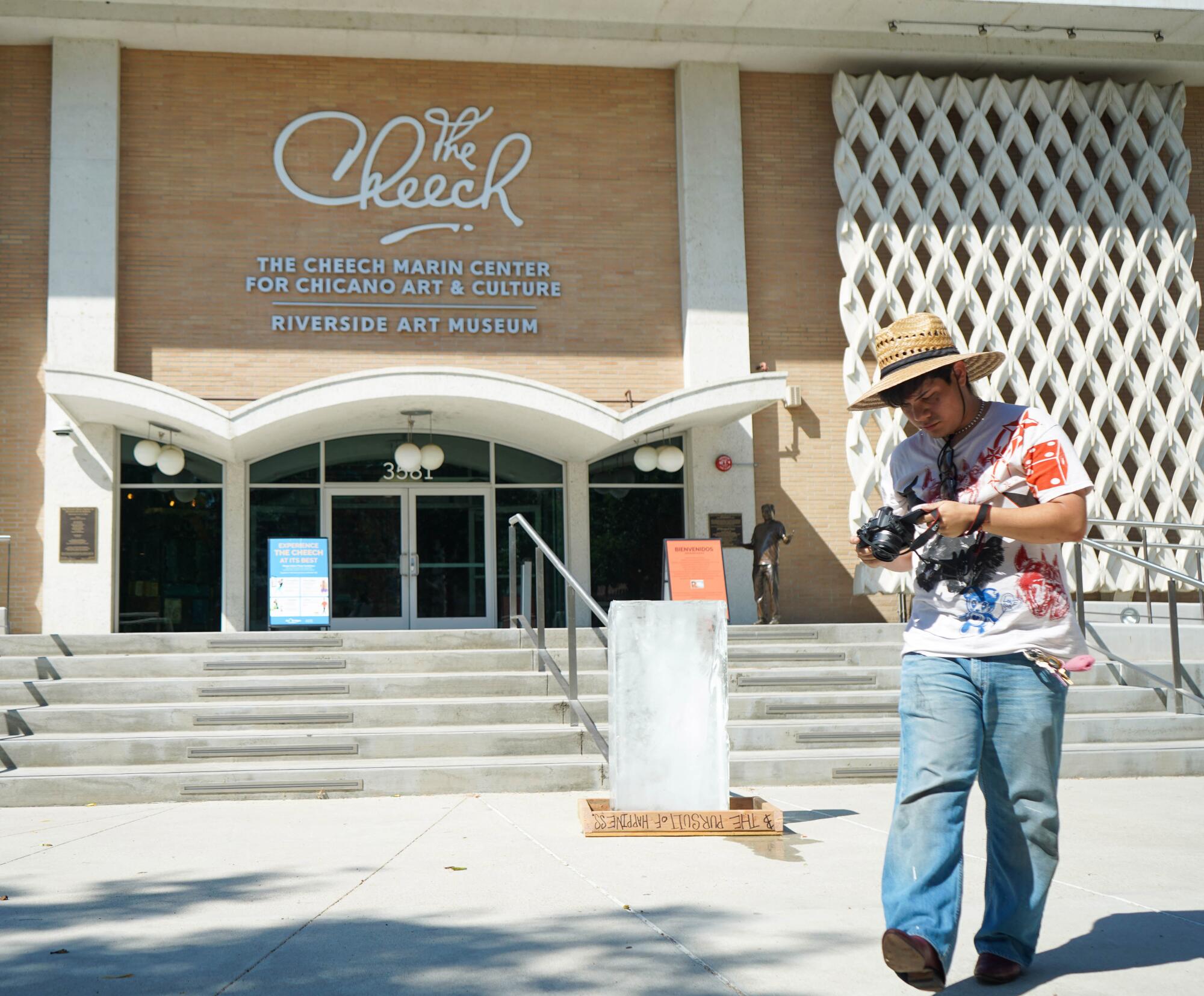
Perry Picasshoe stands outside the Cheech Marin Center for Chicano Art & Culture as part of a performance piece in Riverside on July 3, 2025.
(Daniel Hernandez)
In total, the Cheech has held at least seven different exhibitions that showcased artists from across the Inland Empire — at times, catching Marin’s connoisseur eyes.
“I bought a couple of pieces from different artists because they are of that quality,” Marin said. “It’s great to be encouraging local talent as well as recognizing a larger picture that they are a part of, or going to become a part of [the Cheech].”
According to the Cheech’s spokesperson, Marin has purchased three works from Inland Empire-based artist Denise Silva after they curated an exhibition named “Indigenous Futurism” within the gallery. Another piece, created by artist Rosy Cortez, who has been featured in several exhibitions, was purchased by an anonymous donor and added to the center’s permanent collection.
“We’ve also begun to implement an artist fee for artists who are participating in the exhibitions,” Fernández said, adding that her team has assisted in the transportation of larger works of art as well. “Participating in exhibitions can be cost-prohibitive for artists, and so it’s something we’re trying to mitigate in our practices.”
Their most recent exhibition within the community gallery, called “Hecho en Park Avenue,” has been one of their most successful showings, with over 1,300 community members attending its opening earlier this year.
The exhibition’s co-curator, Juan Navarro, explained that the show culminated years of work within Riverside’s Eastside neighborhood. He, along with other Chicano artists, has been creating art within the Latino-dominant community since 2021.
Then, when the Cheech asked them to curate a show, Navarro felt it was the perfect chance to tell the stories of the Eastside’s locals. The response to the final product was more than Navarro could have ever imagined.
“The community showed out: from intellectuals from UC Riverside, from local government, to state government showed up, to the gang members,” Navarro said. He also noted the emotional weight of being recognized for his art, while surrounded by the work of Chicano artists who waited decades for their own to be recognized.
“Seeing this big, broad community and seeing that our show met the need for a diverse audience… It was meaningful to a lot of people, that’s what I cared about.”
The show’s other co-curator, Michelle Espino, also expressed gratitude for the chance to tell the Eastside’s story at the Cheech. Besides being one of its featured artists, Espino worked on many of the behind-the-scenes aspects of the “Hecho en Park Avenue” exhibition.
It was also a full-circle moment for her; years prior, Espino had written about Fernández’s work for a Chicano art history class. This year, she met with Fernández to ask for advice and to finalize plans for the exhibit.
“It [validated] that I do want to continue with this,” Espino said. “She is literally the person I look up to.”
On top of Espino’s one-on-one meetings with the artistic director, she has also enrolled in a few professional development workshops hosted by the center, most recently taking a class that taught both the art of portraiture and poetry. The Cheech regularly partners with a nonprofit organization named the Riverside Arts Council to host professional development classes.
“If we had these resources when I was younger, my trajectory could have probably been a little bit different,” Espino said.
Marin, in his lifelong quest to collect works for his private collection, has seen how Chicano artists have grown their communities in their respective cities. It starts with painters sharing their works with each other through smaller shows, he said, which builds excitement and increases participation. He likened it to a biological process, where each generation builds upon the growth of the previous iteration.
That process is starting in the Inland Empire now, he added.
“We are a part of this big American picture,” Marin said. “And there’s nothing more official that you can do besides having your own museum.”
Hernandez is a freelance writer based in Riverside. This article is part of a De Los initiative to expand coverage of the Inland Empire with funding from the Cultivating Inland Empire Latino Opportunity (CIELO) Fund at the Inland Empire Community Foundation.
